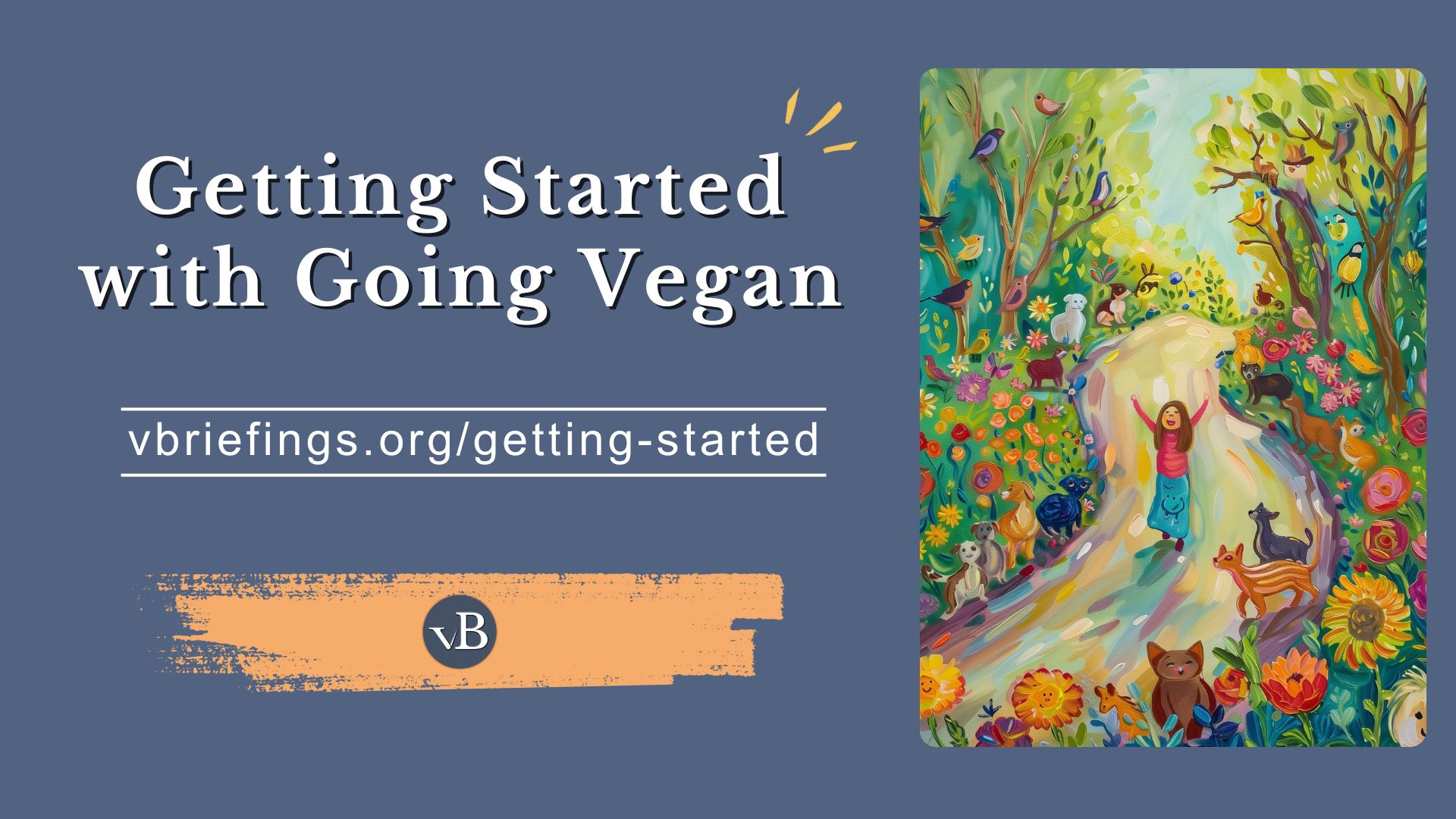Preface
Briefing description and more.
This briefing provides a few practical suggestions for getting started with going vegan, as well as links to resources that can help.
Companion Videos
How to use companion videos
Videos may be posted on multiple social media platforms, and you can share them on each platform according each platform’s conventions.
Share this Briefing
Social Media Sharing Image
This image will be used when sharing the briefing on a social media platform. You can see all social sharing images in the grid view.

How to share this briefing
Click on the icon for the platform on which you wish to share. What happens next depends on the platform, but generally a popup will appear, letting you add your own text as you share.
Briefing Meta
Metrics
Note: we will publish additional briefings after completing flashcards and presentation slides for selected briefings.
Counts:
| Main Text | |
| Key Suggestions | 13 |
| Counterclaims | 1 |
| Supplementary | 3 |
| Further Study | 2 |
| Footnotes | 4 |
| Media & Advocacy | |
| Advocacy Notes | 11 |
| —Socratic Questions | 15 |
| Flashcards | 40 |
| Presentation Slides | 0 |
| Memes & Infographics | 0 |
| Companion Videos | 0 |
Other Meta:
Date Posted:
Last Edited:
Edit Log:
Key Points Links
Loading…
Help Us Improve
Please send your suggestions for improvements, or report any issues with this briefing to team@vbriefings.org
We appreciate that you are taking the time to help up improve. All suggestions and reports will be carefully considered.
Summary
A concise summary of the briefing (see below for citations).
Transitioning to a vegan lifestyle starts with a commitment to change, supported by a transition strategy that’s right for you. Seeking help from local or online vegan communities provides encouragement, answers to questions, and valuable resources. While no vegan is perfect and perfection is impossible, embracing this journey as an adventure opens the door to discovering new foods, recipes, and flavors, making the transition both enriching and enjoyable.
Context
Places this topic in its larger context.
It’s common for someone interested in taking the next steps toward veganism to ask how to go about it.
We hope the suggestions in this briefing will help you make the transition.
It’s also important that you continue to learn about how the ethical, environmental, and human health issues intersect with our exploitation of animals.
Key Points
This section provides talking points.
Make a commitment.
Perhaps the most important way to start is to make a commitment—a promise to yourself to follow some course of action.
Once you read the tips below, particularly the ones involving strategies, commit to the strategies you have chosen and stick to the commitment.
Make the commitment as strong as possible and as concrete as possible.
Realize that perfection is impossible.
Animal products are near ubiquitous—they can be found in bags, car tires, glue, and a wide range of other products for which there are no viable substitutes or for which alternatives are difficult to obtain.
Vegans seek to eliminate harm to animals, according to the most widely accepted definition of veganism, “as far as is possible and practicable…”1
Don’t get frustrated because you can’t be perfect. There are no perfect vegans.
Get support and stay connected.
Seeking connections and support and from other vegans can make your transition easier and more enjoyable. Here are some ways to stay connected and find encouragement.
Find Local Vegan Groups
Look for vegan meetups and Facebook groups in your area that organize potlucks, dining outings, and other social activities. These groups provide a great way to connect with like-minded individuals, share experiences, and get practical advice.
To find vegan groups in a specific location, try searching Google with phrases like “Vegan meetups near [Your City]” or look on Facebook for groups such as “Vegans [Your City]”.
Stay Informed with Vegan News
Keep up with the latest in veganism by following vegan news sources.
- Plant Based News. A leading platform offering the latest updates on veganism, including health, environmental issues, and animal rights.
- VegNews. A popular website and magazine featuring vegan recipes, travel guides, news, and product reviews.
Join Online Support Communities
In addition to local groups, there are several national and international groups dedicated to helping new vegans.
- New Vegan Support is a private Facebook group with over 50,000 members and frequent discussions. While anyone can join, only members can see posts, providing a supportive and private space for questions and advice. Anyone can post, so beware of misinformation.
Get Structured Guidance
Structured programs offer step-by-step support, practical resources, and expert guidance to help you transition to a vegan lifestyle with confidence.
- Vegan Outreach’s “10 Weeks to Vegan” program, which provides weekly tips, resources, and community support to help you successfully transition to a vegan lifestyle.
- Colleen Patrick-Goudreau’s 30-Day Vegan Challenge is a comprehensive paid program designed to guide individuals through a month-long transition to a vegan lifestyle. The challenge offers daily support and resources to address common questions and challenges faced by new vegans.
Transition at a sustainable pace.
There are numerous ways to go about transitioning to veganism—and the process is so personal—that it is virtually impossible to lay out a strict blueprint that will work for everyone. However, you should consider how fast you want to transition.
A good general rule is to proceed as rapidly as you can, but not so fast that you feel overwhelmed and give up. Keep in mind that once the transition has been made, your new ways of eating and purchasing will become second nature.
Choose a grocery transition strategy.
Here are a few overall strategies you might choose in purchasing groceries:
Transition All at Once
Not everyone finds it agreeable to immediately throw out existing supplies of meat, eggs, cheese, milk, and processed foods that have animal ingredients.
For those who can, transitioning all at once shows the highest commitment and encourages success.
In being exposed to the information that contributed to your decision to go vegan, you have likely lost at least some of your appetite for animal products. If this is true for you, then this option is the most viable.
As Food Runs Out
With this strategy, you run down existing supplies and replace animal products with vegan items when the supply of any particular item is exhausted.
Some choose this method because they are on a tight budget.
A Hybrid Strategy
A compromise approach between the above two strategies is to throw out the items that are most obviously animals, such as meat, eggs, cheese, and milk, and then replace other things that have smaller quantities of animal ingredients as they run out.
A Meal or a Type of Food at a Time
Some have chosen to eat vegan for breakfast for a week, then also lunch for the next week, then also dinner.
Others have chosen to replace one food at a time.
For example, you might decide to replace animal milk with plant milk this week and then meat with either vegan meats or whole-food recipes the next week. And so on.
Learn new recipes and how to veganize your favorites.
There are plenty of vegan recipes available with a quick online search. There are many vegan recipe books as well.
As you start to interact with other vegans at meetups—and on Facebook and other platforms—exchanging information on recipes and recipe books will become a joy.
You can also make your favorite recipes vegan by substituting ingredients. Just search for “how to veganize recipes,” and you will be connected to several articles discussing how to accomplish this.
Here are a few popular vegan recipe sites:
- Forks Over Knives, in their recipe section, provides hundreds of healthy, delicious and easy to prepare recipes developed by professional chefs.
- Oh She Glows was created by New York Times bestselling author Angela Liddon, this site offers a wide range of healthy and accessible vegan recipes.
- Nora Cooks offers easy and delicious vegan recipes that are approachable, full of flavor, and made with everyday ingredients.
Become familiar with food labeling.
Note: Some vegans choose to overlook trace animal ingredients in packaged foods or products, recognizing that perfection isn’t practicable or possible.
Many foods have ingredients with names that obscure that the ingredients are derived from animals.
Some ingredients are almost always animal-based. These include albumin, aspic, casein, cod liver oil, collagen, elastin, gelatin, honey, isinglass, keratin, lactose, lard, pepsin, propolis, royal jelly, shellac, tallow, certain forms of vitamin D3, and whey.2
Other ingredients, such as glycerine, glycerol, lactic acid, mono- and diglycerides, and stearic acid, can come from either animal or plant sources.3 Hopefully, the label will indicate if they are plant-derived.
Online resources and apps can help:
- Is It Vegan provides an app that allows users to scan product barcodes to determine if they are vegan. It analyzes ingredients and provides a clear answer, helping users make informed choices while shopping.
- Double Check Vegan is a free online tool that allows users to verify the vegan status of products by pasting a list of ingredients.
Plan for eating out.
Dining out as a vegan is easier than ever with the growing availability of plant-based options. Before eating out, it’s a good idea to check the online menu and call ahead with any questions about what is vegan or can be made vegan. This can help you avoid surprises and ensure a smoother experience. Also, you should never hesitate to ask your server for clarification.
Supporting fully vegan restaurants whenever possible helps grow demand for ethical dining options, but if you’re eating at an establishment without vegan options, simple modifications and plant-based substitutions can often be accommodated.
Apps and online guides can make it easier to find vegan-friendly restaurants in your area:
- Veggl provides a comprehensive online guide and a mobile app showing vegan options at chain restaurants, airports, and sports venues across the U.S.
- Happy Cow‘s website and mobile app will help you find vegan-friendly restaurants and cafes. Users can search for nearby establishments, read reviews, and view photos.
- Barnivore‘s website provides an extensive online directory for information on the vegan status of beers, wines, and liquors—useful for ordering at restaurants or buying in a store.
Choose vegan-friendly entertainment, clothing, furniture, and sundries.
As you make progress on food, consider your purchases in other areas that might involve animal exploitation. Note that some vegans choose to overlook trace animal ingredients in packaged products, recognizing that perfection isn’t practicable or possible.
Entertainment & Experiences
Many people assume that zoos, aquariums, rodeos, and circuses are harmless, but a closer look reveals systemic cruelty and exploitation. Look into ethical alternatives—natural history museums, human circuses such as Cirque du Soleil , and farm animal sanctuaries.
Clothing & Furniture
Animal-derived materials like leather, wool, and silk come from industries built on suffering. As you transition, you might choose to:
- Use your existing non-vegan items until they wear out, replacing them with vegan alternatives over time.
- Donate them to reduce waste while ensuring they continue to be used.
- Discard them to fully disengage from industries built on exploitation.
Personal & Household Products
Many soaps, cosmetics, cleaning supplies, and everyday items contain animal-derived ingredients or have been tested on animals.
- Look for the Leaping Bunny symbol:
 . Leaping Bunny is the most trusted certification and requires independent audits.
. Leaping Bunny is the most trusted certification and requires independent audits. - Look for the following wording on product packaging: “Not Tested on Animals”, “Cruelty-Free”, “100% Vegan & Cruelty-Free.”
Several online guides and mobile guides are available to help you purchase vegan and cruelty-free products. One such guide is Redfin’s “The Ultimate Guide to Make Your Home 100% Cruelty-Free and Vegan.”4
Be prepared for the social ramifications.
It’s not unusual for those new to veganism to feel a little isolated from family and friends during mealtime. You will experience various degrees of understanding and acceptance from those you care about.
As time moves forward and they see how important your commitment is to you, almost everyone will accept your choices. Many will admire your conviction.
You need to keep in mind the reasons you became vegan, remember what it was like to not be vegan, and give others time to accept and embrace your compassionate way of living.
It’s likely that some of your family and friends will eventually become vegan because of the example you set and your conviction. With this in mind, it’s helpful to think of others as pre-vegans.
Bring a vegan dish when asked over for dinner.
There is no need to panic when you’re asked over for dinner by friends, acquaintances, or family.
If your hosts don’t know you’re vegan, you should mention it to them as casually as possible. Then you should offer to bring a delicious vegan dish that can be enjoyed by everyone.
Keep educating yourself.
As you have no doubt discovered, there is a wealth of information available about veganism on this site and others.
Never stop learning and growing.
Think of going vegan as the adventure it is.
Many have found leaving animals off the plate to be an adventure, discovering new foods, recipes, and tastes they have never before experienced. Like many changes, being vegan will soon be second nature.
Counterclaims
Responses to some yes but retorts.
The topic of this briefing doesn’t exactly lend itself to counterclaims, but our briefings on objections to veganism to veganism may help.
Supplementary Info
Additional information that may prove useful.
Video: How to Start a Vegan Diet
This video guide offers practical advice on adopting a plant-based diet. The content covers essential topics such as meal planning, nutritional considerations, and tips for maintaining a balanced diet without animal products. The creator also shares personal experiences and insights to help newcomers navigate common challenges associated with going vegan.
Video: Ed Winter’s How to Go Vegan
This popular video by Ed Winters provides practical advice and tips for those interested in going vegan, addressing common concerns and offering strategies for making the switch.
Video: Plant-Based Eating: First 21 Days
In this video, Dr. Neal Barnard explains what happens when you adopt a plant-based diet, and provides some tips for making the transition.
Further Study
Sources providing a deeper understanding of the topic or related topics.
Other Resources
See the links provided throughout this briefing for additional resources such as recipe websites and mobile apps, and the videos in the supplementary info section of this briefing for help in getting started.
Advocacy Resources
Information to help with outreach and advocacy.
Note: we will publish additional briefings after completing flashcards and presentation slides for selected briefings.
Share This Briefing
Cloned from the Preface Section on page load.
Companion Videos
Cloned from the Preface Section on page load.
Memes and Infographics
No images found.
How to use Memes and Infographics
To sequence through all memes and infographics on this page, click on any image than use the arrow keys or the arrow buttons to show next and previous images.
To share a meme or infographic, right click on the image and choose download or save as. Then upload the image to the platform of choice.
Presentation Slides
Slides not available.
How to Use the Presentation Slides
You can view the slideshow full screen by clicking on the first link above.
To use Canva presenter mode, view the speaker notes, or download the slides as PowerPoint, login to Canva (the free account works) and follow the Full Canva Link provided above.
To copy this presentation to your own Canva project, use the Full Canva Link provided above, then select File->Make a Copy from the upper left. You can build your own unique presentation from multiple briefings by copying the presentation from each briefing and then building another presentation from the copied presentations.
Flash Cards
We partner with Brainscape because of their excellent features for learning. You will need to create a free Brainscape account to study the cards.
Go to Flash Cards: This will take you to a list of decks.
About Flash Cards and Brainscape
Flash cards are here to help you commit important facts and concepts in this briefing to memory.
In Brainscape, there is one deck for each briefing. You can study more than one deck at a time. Brainscape uses spaced repetition to promote memory retention. It is “the secret to learning more while studying less.”
You can study using your browser, but Brainscape also has a free mobile app that makes learning anywhere easy.
Socratic Questions
Socratic-style questions are embedded in the Advocacy Notes below, and shown in italics.
These are open-ended, thought-provoking questions designed to encourage critical thinking, self-reflection, and deeper understanding. They are inspired by the Socratic method, a teaching technique attributed to the ancient Greek philosopher Socrates, who would ask his students probing questions rather than directly providing answers.
The goal is to help people examine their beliefs, clarify their thoughts, uncover assumptions, and explore the evidence and reasoning behind their ideas.
Advocacy Notes
Tips for Advocacy and Outreach
General Tips
Many people are open to the idea of going vegan but feel overwhelmed about where to start. Your goal isn’t just to give them steps—it’s to remove barriers, provide reassurance, and make the transition feel exciting rather than daunting.
If you are conveying these suggestions to a vegetarian, remember to encourage them toward veganism rather than demean them for steps they have already taken.
Keep some pamphlets or brochures with easy recipes and other information on hand, ready to give to give them. This makes it easier for them to explore veganism on their own time, reinforcing the conversation and giving them practical steps to take without pressure.
Find out and Address What’s Stopping Them
“I sense you really do want to align your values of compassion, justice, and sustainability with your personal choices. So what’s stopping you from giving it a try? Maybe I can help with that.”
Why? This helps them recognize that their hesitation isn’t about a lack of alignment with vegan values but about perceived barriers—barriers that can often be overcome with support and practical guidance.
Don’t Overload Them—Keep It Simple
One mistake in outreach is giving too much information at once. Instead of listing every possible resource, meet them where they are.
- What’s one animal product you think would be easiest for you to swap out?”
- “Would you like a couple of really easy meal ideas to start with?”
Why? This turns a big lifestyle change into a small, manageable step.
Reassure Them That Perfection Isn’t Required
Some people hesitate to try veganism because they think they’ll fail or won’t do it “perfectly.” Help them let go of that pressure.
- “Did you know veganism isn’t about being perfect—it’s about doing the best we can?”
- “If you accidentally eat something with animal products, do you think that means you’ve ‘failed,’ or is it just part of learning something new?”
Why? This removes the fear of failure, making them more likely to try.
Offer Different Transition Strategies
Not everyone can or wants to go vegan overnight. Instead of pushing one method, help them find what works for them.
- “Some people go vegan all at once, some do it meal by meal, and others replace one product at a time. Which approach sounds easiest for you?”
- “If you’re not ready to drop everything, what do you think about starting with one vegan meal a day?”
Why? This gives them options so they feel in control of the process.
Make It Social—They Don’t Have to Do It Alone
People worry about feeling isolated when they go vegan. Show them they can find support.
- “Have checked out any local vegan meetup groups or online support groups? It’s easier when you have support.”
- “Did you know there are Facebook groups just for new vegans where people share easy recipes and get advice?”
Why? This makes veganism feel more social and inviting rather than lonely.
Address Concerns About Eating Out
Eating out is a major concern for people considering veganism. Help them prepare.
- “Did you know that almost every restaurant has vegan options now? What’s your favorite place to eat—I can probably tell you what’s vegan there!”
- “Have you ever checked menus online before going out? This can help you avoid awkwardness with friends when you get there. If they don’t seem to have good vegan options, give them a call to see what they can do.”
Why? This removes the fear of inconvenience, making veganism feel practical.
Show Them That They Don’t Have to Give Up Their Favorite Foods
One of the biggest fears people have is that they’ll miss their favorite foods. Help them see that they don’t have to.
- “If you love burgers, pizza, or ice cream, there are vegan versions of all of them. Have you ever tried one?”
- “You don’t have to give up comfort foods—you just swap out ingredients. Would you like some help with that?”
Why? This makes veganism feel like a swap, not a sacrifice.
Give Them a Reason to Be Excited About It
If they see veganism as a burden, they won’t want to try. Frame it as an adventure instead.
- “Most people eat the same foods every week—have you ever thought about how going vegan could be a chance to discover amazing new meals?”
- “Have you ever thought of veganism like traveling to a new country, where you get to explore different flavors, ingredients, and ways of cooking?”
Why? This makes veganism exciting, not restrictive.
Footnotes
Our sources, with links back to where they are used.
- “Vegan Society – About Us – History” The Vegan Society. Accessed 2022-06-22. ↩︎
- A Vegan’s Guide to Reading Food Labels.” Vegan Food & Living, February 23, 2018. ↩︎
- A Vegan’s Guide to Reading Food Labels.” Vegan Food & Living, February 23, 2018. ↩︎
- “The Ultimate Vegan and Cruelty-Free Guide for Your Home.” Redfin Real-Time, January 2016. ↩︎




